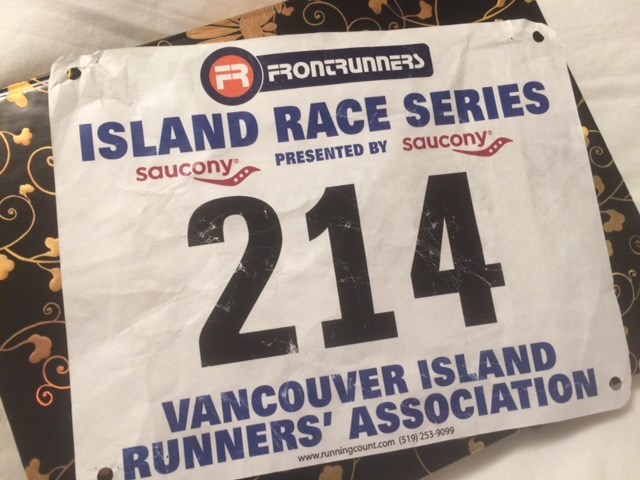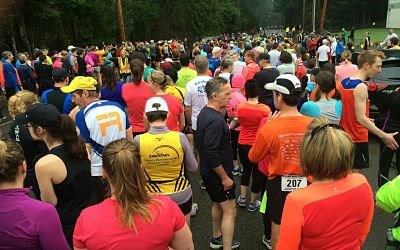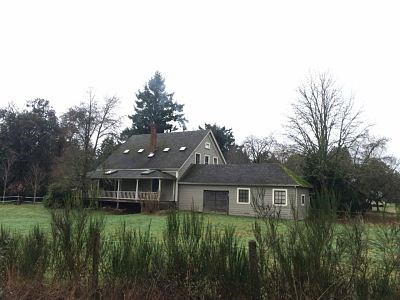Label me half-in, half-out. Label me naïve. Or just pin a race a bib on me and give me a shove.
What in the hell am I doing running races so early in 2015?

The Vancouver Island Race Series is a tradition from Sooke to Comox
------
Wanting to do something different with my running this year, I signed up for the Vancouver Island Race Series.
Yes, I knew the eight races started in January.
Yes, I knew that January is immediately after December.
Yes, I knew December is heavy on indulgences, light on training. Tack on the typical rest after races in October and November that many runners take and you’ve got the ideal conditions for a slow re-entry into regular running at this time of year.
That’s what I’m used to: sign up for a running clinic that starts mid or late January and gently increase my running distance as the clinic shuffles people into appropriate pace groups – all with the aim of a half-marathon in early May.
The build is toward the climax of a single race, so I am not mentally or physically prepared for all this fumbling foreplay and quickies.
This year with the VIRS, the first race was 8K on January 8 and two weeks later, this past weekend, some 600 people gathered for the Cobble Hill 10K.

Runners of all ages get ready for the air-horn start
-----
I had no idea of how I’d ‘perform’ having trained most of last year for a marathon at a slower pace. My 8K two weeks ago was decent but you can fake it at that distance – heavy panting and all.
Wondering how much of our fitness we lose over an extended absence due to injury, holiday or competing work or family commitments, I did a bit of research. There’s even a term for it – “detraining.” And I have seriously “detrained.”
An often-cited study was done by the former dean of the University of Alberta’s School of Physical Education, Arthur Quinney and Elizabeth Ready.
They studied two groups of men – one group of 12 cyclists rode hard for 30 minutes, four times a week for nine weeks. The other group of nine guys got the tough assignment of doing nothing. No word if it involved football and Doritos.
By measuring the cyclists’ V02 max and anaerobic threshold before and then every three weeks, the study found that after training stopped the cyclists’ fitness quickly declined. (V02 max is the body’s uptake of maximum oxygen – which affects muscle function. The more oxygen that can get to your muscles, the better.)
After three weeks of ‘detraining,’ the cyclists’ anaerobic threshold and V02 max dropped by almost 20% but then the decrease leveled off.
That doesn’t sound so bad to me. After nine weeks, the cyclists retained about 40% of their gain in fitness.
Other researchers studied seven endurance athletes who train year after year. Edward Coyle et al. measured how their fitness declined at various points of ‘detraining’ over a total of 12 weeks of inactivity.
The initial drop-off in fitness was fairly quick: after 12 days, levels of enzymes in the blood associated with endurance performance had decreased by 50%, and V02 max had dropped by 7%. But again, the reduction in fitness leveled off – suggesting the physiological changes in seasoned athletes, such as the number of small blood vessels that grow deep into the muscles, delivering that vital oxygen, aren’t affected.
For elite athletes, I can see how any percentage drop in fitness is of concern, but for me – I just want to know how long it’s going to take before I again feel stronger and faster.
This was tested along the foggy, scenic rural roads of Cobble Hill where I had no idea what I had in my legs and lungs, even if I did have some kick-ass music on my iPod. If I ran under 1:15, I’d accept that.

The race route passes country houses, pasture lands and rural acerages.
-----
Having forgotten my GPS watch at home, I considered my naked left wrist as a sign that time shouldn’t matter on this day.
I have to admit when I spied the 5K marker, I wrestled my phone out of my waist belt to sneak a peek. Not bad, I thought, doing some quick math.
"Nobody's going to see me coming. Nobody's going to hear a sound. No matter how hard they're trying. Nobody's going to bring me down."
------
My inner Ninja surfaced and I visualized a target on the back of a man 50 metres ahead of me with longer, more luxurious hair than my own and about my age. I can take him, I thought.
After 50 metres, the swinging mane was even further ahead. I switched targets for a woman 20 metres in front of me. Definitely older. And my hair’s longer. I can take her.
Uhm, no (it becomes apparent), I can’t.
OK, well, I’ll damn well just run as best as I can. Which obviously doesn’t necessarily mean fast, but fast for me, on this day, with my legs.
Turns out, I did break one-hour. Next up is the Cedar 12K on Feb. 8. Everyone keeps talking about the route’s hills. Sigh.


